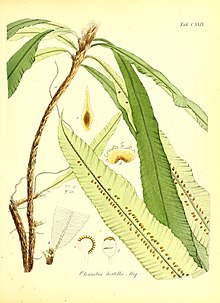Oleandra
| Oleandra | ||||||||||||
|---|---|---|---|---|---|---|---|---|---|---|---|---|

Oleandra wallichii , illustration |
||||||||||||
| Systematics | ||||||||||||
|
||||||||||||
| Scientific name of the family | ||||||||||||
| Oleandraceae | ||||||||||||
| ( J.Sm. ) Ching ex Pic.Serm. | ||||||||||||
| Scientific name of the genus | ||||||||||||
| Oleandra | ||||||||||||
| Cav. |
Oleandra is the only genus of the Oleandraceae plant family within the real ferns (Polypodiopsida). The 15 to 20 species thrive in tropical and subtropical regions almost worldwide.

description
Oleandra species are perennial herbaceous plants . They thrive terrestrially , epilithically or hemi- epiphytically . The Balttwedel are simple.
The Sori have rounded kidney-shaped indusia . The spores are kidney-shaped. The basic chromosome number is x = 41.
Systematics and distribution
The genus Oleandra was established in 1799 by Antonio José Cavanilles . A synonym for Oleandra Cav. is Neuronia D.Don. The family Oleandraceae ( J.Sm. ) Ching ex Pic.Serm. was set up by Ren Chang Ching (1898–1986) in Rodolfo Emilio Giuseppe Pichi-Sermolli .
The genera Arthropteris and Psammiosorus, which often belong to the Oleandraceae family, are described by Smith et al. 2006 added to the family of Tectariaceae . The Oleandraceae family is monogeneric:
The genus Oleandra is pantropical. The species occur mainly from tropical Asia to Pacific islands. Few species occur in Africa and South America. There are five types in China.
- There are 15 to 20 species in the genus Oleandra , including:
- Oleandra articulata (Sw.) C. Presl : It occurs from southern Mexico through Central America to Colombia and Venezuela .
- Oleandra cumingii J.Sm. (Syn .: Oleandra cantonensis Ching , Oleandra chinensis Hance , Oleandra guangxiensis S.L. Mo & YCZhong , Oleandra intermedia Ching , Oleandra yunnanensis Ching ): It spreads in South and Southeast Asia and occurs there in Laos , Thailand , Malaysia , Indonesia , in the Philippines and in the Chinese provinces of Guangdong , Hainan and Yunnan .
- Oleandra musifolia (flower) C. Presl ( Syn .: Oleandra hainanensis Ching , Oleandra whangii Ching ): It occurs in Sri Lanka , Vietnam , Indonesia, Malaysia, Thailand and in the Chinese provinces of Guangxi, Hainan and Yunnan.
- Oleandra neriiformis Cav. (Syn .: Oleandra pistillaris (Swartz) C.Christensen ): It occurs in India , Bhutan , Nepal , Myanmar , Tibet , Thailand, Cambodia , Malaysia, Indonesia, the Philippines, Papua New Guinea and the Pacific Islands.
- Oleandra nodosa (Willd.) C. Presl : It occurs in the Neotropics and in Guinea only on the island of Bioko (former name Fernando Po).
- Oleandra undulata (Willd.) Ching : It occurs in India, Myanmar, Laos, Thailand, Vietnam and Yunnan.
- Oleandra wallichii (Hook.) C. Presl : It occurs in northern India, Bhutan, Nepal, northern Myanmar, Thailand, Vietnam, Tibet, Taiwan and in the Chinese provinces of Guangxi, Sichuan and Yunnan.
swell
literature
- Alan R. Smith, Kathleen M. Pryer, Eric Schuettpelz, Petra Korall, Harald Schneider, Paul G. Wolf: A classification for extant ferns. In: Taxon. Volume 55, No. 3, 2006, ISSN 0040-0262 , pp. 705-731, abstract, PDF file .
- Zhang Xianchun, Peter H. Hovenkamp: Oleandraceae , p. 747 - online with the same text as the printed work , In: Wu Zheng-yi, Peter H. Raven, Deyuan Hong (ed.): Flora of China. Volume 2-3: Lycopodiaceae through Polypodiaceae. Science Press and Missouri Botanical Garden Press, Beijing and St. Louis, 2013, ISBN 978-1-935641-11-7 .
Individual evidence
- ↑ a b c d e f g h i j Zhang Xianchun, Peter H. Hovenkamp: Oleandraceae , p. 747 - online with the same text as the printed work , In: Wu Zheng-yi, Peter H. Raven, Deyuan Hong (eds.): Flora of China. Volume 2-3: Lycopodiaceae through Polypodiaceae. Science Press and Missouri Botanical Garden Press, Beijing and St. Louis, 2013, ISBN 978-1-935641-11-7 .